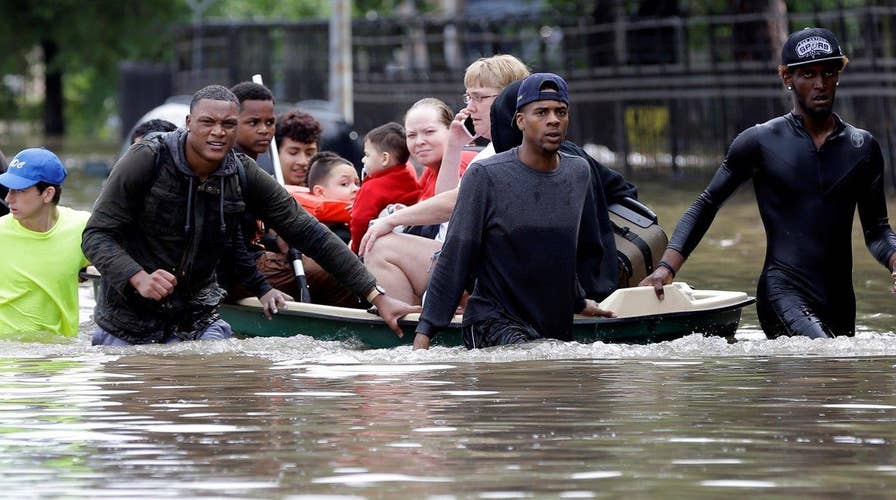Houston officials said Tuesday six people were confirmed dead after flash flooding dumped more than a foot of rain on the city and surrounding towns.
"I regret anyone whose home is flooded again," Houston mayor Sylvester Turner said. "There's nothing I can say that's going to ease your frustration. We certainly can't control the weather."
The Harris County Institute of Forensic Sciences said three people were killed in the City of Houston, two in Harris county, and one in Waller County.
Flash flooding and a 50 percent chance of more were possible Tuesday, a day after nearly 18 inches fell in 24 hours. The National Weather Service had the area under a flash flood watch through Wednesday morning.
Scores of subdivisions were flooded and most schools remained closed although the city itself was returning to normal. Municipal offices reopened Tuesday and by midmorning, less than 10,000 CenterPoint Energy customers were without power, an improvement from 24 hours earlier when electricity outages topped 100,000. Houston's Metropolitan Transit Authority resumed service and most highways within the city were open.
Outside the city and into the suburbs of northwest Harris County, runoff from Monday's rains forced creeks over their banks and forced more people to evacuate their homes overnight.
In addition to its location, Houston's "gumbo" soft soil, fast-growing population and building boom that has turned empty pastures into housing developments all over the city's suburbs and exurbs make it vulnerable to high waters.
Harris County has seen a 30 percent jump in population since 2000. Its surrounding counties have almost grown more than 10 percent since 2000, according to the Greater Houston Partnership, a business group.
Some of the resulting developments include adequate greenspace for water runoff, but not all of them do, said Philip Bedient, an engineering professor at Rice University.
"Could we have engineered our way out of this?" Bedient said. "Only if we started talking about alterations 35 or 40 years ago."
Samuel Brody, director of the Environmental Planning & Sustainability Research Unit at Texas A&M University, has called Houston "the No. 1 city in America to be injured and die in a flood."
He said Tuesday that mounting damages from flash floods point to a woeful lack of planning in a city that added 90,000 people last year alone and is a major cog in the national economy. He suggested the city should offer buyouts to homeowners in areas that chronically flood and turn the land into open space. The city should also upgrade its building code to mandate elevating structures in flood-prone areas, he said.
"To throw up your hands and say we're going to be vulnerable and have hundreds of millions of dollars of impact every year in Houston just because it rains a lot is not the attitude we need to take," Brody said. "We are not thinking about the big picture."
Rainstorms last year over Memorial Day weekend caused major flooding that required authorities to rescue 20 people, most of them drivers, from high water. Drivers abandoned at least 2,500 vehicles, and more than 1,000 homes were damaged in the rain.
The year before, flash flooding in Houston and suburban counties left cars trapped on major highways.
Those storms still pale in comparison to the devastation wreaked by Hurricane Ike in 2008 and Tropical Storm Allison in 2001. Allison left behind $5 billion in damages and flooded parts of downtown and the Texas Medical Center, which sits near the Brays Bayou, a key watershed.
The National Weather Service's chief meteorologist for Houston, Jeff Evans, said Monday's soaking and the 2015 Memorial Day deluge were the second- and third-biggest rain events on record after Allison, which dumped more than 30 inches of rain on parts of the sprawling city over two days.
Asked if man-made climate change could be a factor, he said the data is unclear but that the El Nino weather phenomenon, caused by heightened surface temperatures in the eastern Pacific, could "be a player in why we're had so many big rain events this year."
Evans said rain fell in some places Monday at a rate of 3-4 inches an hour.
"No matter what drainage system you build, anything will struggle with that kind volume in that short a time," he said.
Bedient has worked with the Texas Medical Center on better preparing its facilities for massive rainfall, including the use of a sophisticated weather alert system that gives the medical center extra time to activate gates and doors that block excess rainwater.
Improving the monitoring of specific watersheds and flood-prone areas might give affected residents the extra bit of time they need to save lives and take protective measures.
"We can't solve this flood problem in Houston," Bedient said. "All we can do is a better job warning."
The Associated Press contributed to this report.


